
When it comes to environments exposed to moisture or staining agents, homeowners need to consider the right flooring material. Flooring materials like solid wood, carpeting, and laminate are often unsuitable for such spaces. This is where vinyl tile and ceramic tile come into play. Both types of tile are excellent choices for high-traffic and highly wet rooms like kitchens and full bathrooms due to their ability to shed moisture and resist stains.
Vinyl tile is a synthetic flooring material often designed to mimic hardwood, stone, or ceramic tile. It differs entirely from ceramic tile, meaning they have different installation, maintenance, and real estate resale value characteristics. Learning about the major differences between vinyl and ceramic tiles will help you choose the right flooring.
Vinyl Tile

Vinyl tile or Luxury Vinyl Tiles (VLT) is a type of vinyl flooring that comes in tile form and is used as a flooring solution. Through photographic technology, it is designed to mimic the look of other materials, such as hardwood, stone, or ceramic tile. Vinyl tiles are made from synthetic materials and are highly durable, water-resistant, and easy to maintain. They are popular for homeowners who want a low-maintenance flooring option to withstand foot traffic and natural elements.
Vinyl tiles are a cost-effective alternative to other flooring materials, such as ceramic tiles or hardwood planks. They are also a selling point for many homeowners due to their easy installation and low maintenance. However, improper installation of LVT can release toxic gases into the air during manufacturing, so it is important to ensure they are installed correctly. Additionally, vinyl tiles are not as durable as ceramic tiles and can be easily scratched by sharp objects.
Ceramic Tile
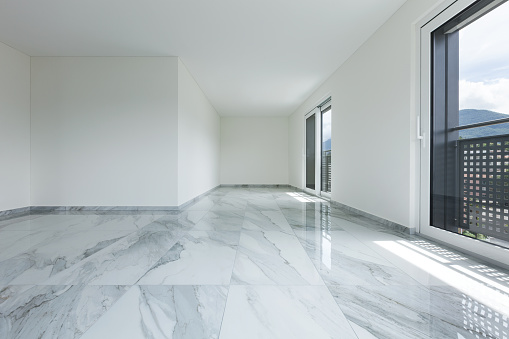
Ceramic, porcelain, or wood-look tile is a highly durable flooring material made from natural clay that is shaped, fired, and glazed to create a hard, durable surface. It is a flooring solution that is highly resistant to water and stains, making it an ideal option for high-traffic and highly wet areas like kitchens and bathrooms. Ceramic tiles come in different shapes, sizes, and colors, including porcelain tiles, which are highly durable and withstand extended foot traffic.
Compared to vinyl flooring, porcelain tile is more durable and can last many years without showing signs of wear and tear. Vinyl tile flooring is a synthetic material that uses photographic technology to mimic the look of hardwood, stone, or ceramic tile. While vinyl flooring is easy to clean and maintain, it is not as durable as ceramic tile and can release toxic gases during manufacturing.
Vinyl Plank Flooring Vs. Ceramic Tile: The Main Differences
Vinyl plank flooring and ceramic tile are two popular choices that offer different benefits and drawbacks. Here are the main differences between vinyl plank flooring and ceramic tile regarding water and heat resistance, care and cleaning, durability and maintenance, installation, cost, sizes, comfort, and sound.
Water and Heat Resistance
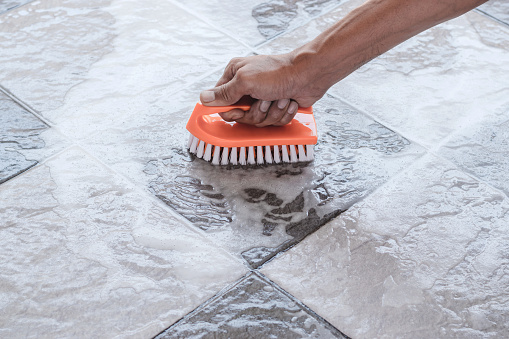
Vinyl Tile
One of the most significant differences between vinyl plank flooring and ceramic tile is their water and heat resistance. Vinyl plank flooring is highly water-resistant and can withstand spills, humidity, and even water damage. It’s also heat-resistant, making it an excellent choice for underfloor heating systems.
Ceramic Tile
Ceramic tiles are also water-resistant but not impervious to water damage. If water seeps into the grout, it can cause damage to the subfloor. Wood-look tiles are also not heat-resistant and can crack or warp if exposed to high temperatures.
Best for Water and Heat Resistance: Ceramic Tile
Both ceramic and vinyl tile have their strengths and weaknesses regarding water and heat resistance. While both materials have good resistance to water damage, they can both be susceptible to moisture seeping down to the subfloor through their seams. However, ceramic tile is considered virtually impervious to heat, while vinyl tile is vulnerable to damage from high temperatures. Therefore, if you prioritize resistance to heat, ceramic tile is likely the better choice for your needs.
Care and Cleaning
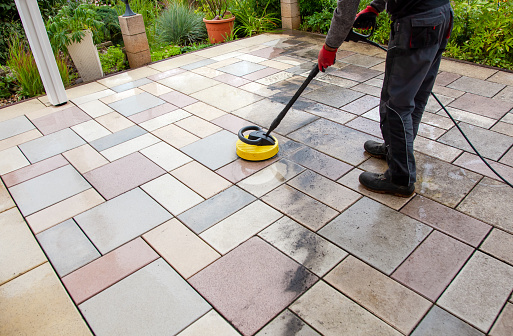
Vinyl Tile
Vinyl plank flooring is low-maintenance and can be cleaned with mild cleaners and a dust mop. It’s also resistant to scratches and dents, making it ideal for high-traffic areas.
Ceramic Tile
Ceramic tiles require regular cleaning with warm water and mild detergent, and the grout lines need to be sealed regularly to prevent staining. Ceramic tiles are also prone to scratches and chips, making them less durable than vinyl plank flooring.
Best for Care and Cleaning: Vinyl Tile
Vinyl tile is the easier flooring material to keep clean due to its smooth surface without grout lines or embossing. Unlike ceramic tile, which can accumulate debris, stains, and mildew in these areas, vinyl tile does not have such crevices that can be difficult to clean. Therefore, vinyl tile may be better if you prioritize ease of care and cleaning.
Sizes

Vinyl Tiles
Vinyl plank flooring comes in a wide range of sizes and thicknesses and can be cut to fit any room’s dimensions.
Ceramic Tile
Ceramic tiles also come in various sizes, but the most common sizes are 12×12, 16×16, and 18×18 inches. The tile size can affect the installation process, as larger tiles can be more challenging to install and require more precise cuts.
Best for Sizes: Ceramic Tile
Ceramic tile offers a wider range of size and shape options compared to vinyl tile, making it a better choice for those who desire more versatility in their flooring choices.
Durability and Maintenance

Vinyl Tile
Vinyl plank flooring is highly durable and can withstand extended foot traffic, and wear and tear. It’s also a very low-maintenance flooring solution, and if installed correctly, it can last for many years.
Ceramic Tile
Porcelain tiles are also durable but require more maintenance than vinyl plank flooring. They’re prone to cracking and chipping, and the grout lines need to be sealed regularly to prevent staining and discoloration.
Best for Durability and Maintenance: Ceramic Tile
Ceramic tile is known for its exceptional durability and is considered one of the toughest flooring materials available. It can withstand a range of wear and tear, making it highly damage-resistant, except for cracking. With proper maintenance, ceramic tile can last for many years.
Comfort and Sound
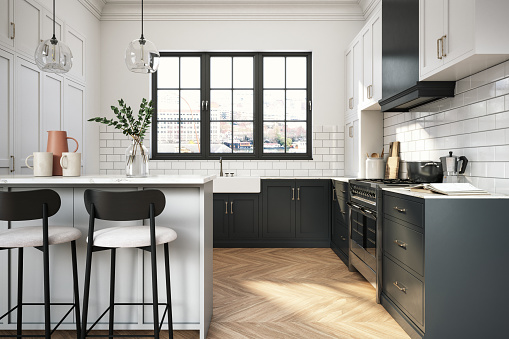
Vinyl Tile
Vinyl plank flooring is a softer and more comfortable flooring option than ceramic tiles, as it has a little more give when you walk on it. It’s quieter than wood-look tiles and doesn’t produce the same echoing sound when walking on it.
Ceramic Tile
Ceramic tiles, on the other hand, are harder and can be uncomfortable to stand on for extended periods. They also tend to produce more noise and echoing sounds when you walk on them.
Best for Comfort and Sound: Vinyl Tile
Regarding comfort and sound, vinyl tile is the better choice between the two materials. While both types of flooring can feel fairly hard underfoot, vinyl tile is slightly softer than ceramic tile, making it more comfortable to stand on for extended periods. Additionally, vinyl tile also provides better sound insulation than ceramic tile, which can help to reduce noise transmission between floors.
Installation
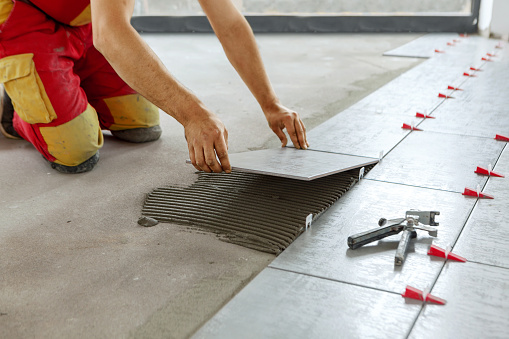
Vinyl Tile
Vinyl plank flooring comes in planks or tiles and can be installed as a floating floor, direct glue-down, or interlocking tiles.
Various forms of luxury vinyl planks and tiles are installed as floating floors, in which individual pieces are joined together with a snap-lock system that holds the planks or tiles together along the edges. The installation method resembles that used for laminate flooring and is extremely easy for DIYers.
Ceramic Tile
Ceramic flooring tiles are installed using mortar and grout, and the installation process is more complicated and time-consuming than vinyl plank flooring. Installing ceramic tile correctly is also more challenging; improper installation can damage cracked tiles or water.
Best for Installation: Vinyl Tile
Luxury vinyl tile is a great flooring option for those who prefer to do their own installation. It is a straightforward process that doesn’t require much expertise, as vinyl tile is easy to cut and doesn’t need thin-set mortar. On the other hand, ceramic tile installation requires specialized skills that are developed over time, and it can be a labor-intensive process. Although DIYers can certainly install ceramic tile on a small scale, it may be best left to professionals for larger projects.
Cost

Vinyl Tile
The cost of vinyl plank flooring and ceramic tiles can vary widely depending on the quality, size, and installation method. Generally, vinyl plank flooring is more affordable than Porcelain tiles and less expensive to install. However, the cost can vary depending on the vinyl plank flooring’s brand, quality, and thickness.
Ceramic Tile
Ceramic tiles are generally more expensive than vinyl plank flooring, and the installation costs can also be higher.
Best for Cost: Vinyl Tile
Vinyl planks are a more cost-effective flooring option compared to ceramic tiles since vinyl tile installation requires fewer specialty tools and additional materials. Vinyl tiles are also generally less expensive than ceramic tiles, making them a more budget-friendly choice for those looking for a low-cost flooring solution.
Vinyl tiles and Ceramic Tiles: A draw
Aesthetics and Appearance
There is no clear winner regarding the aesthetics and appearance of ceramic and vinyl tiles. Both materials come in various colors and patterns, allowing you to achieve the look and feel you want in your space.
Ceramic tile often has a more natural and upscale look due to its clay composition, while vinyl tile can mimic the appearance of other flooring materials, such as hardwood or stone, using photographic technology. Ultimately, the best choice for your project will depend on your style preferences and the design goals you want to achieve.
Stain Resistance
Stain resistance is an area where both ceramic tile and vinyl tile excel. Both flooring options are highly durable and resistant to staining, making them an excellent choice for high-traffic areas and homes with children or pets.
However, it is important to note that certain materials, such as nail polish remover or harsh chemicals, can cause damage or discoloration to ceramic and vinyl tile if not cleaned up promptly. As such, it is important to use mild cleaners and avoid sharp objects or abrasive materials that could scratch or damage the flooring.
Overall, ceramic and vinyl tiles are excellent choices for homeowners seeking a durable, stain-resistant flooring solution.
Resistance to Water
Both ceramic tiles and vinyl tile flooring have water-resistant properties, but luxury vinyl and plank flooring are more water-resistant than wood-look tiles. Porcelain and ceramic tiles are moisture-resistant and can withstand water exposure, but they are not entirely waterproof. On the other hand, luxury vinyl tile and plank flooring are waterproof and can resist water damage better than other options like hardwood or stone floors.
When choosing between ceramic tile and vinyl tile flooring, consider the level of water resistance needed for your space, and select a flooring option that offers sufficient moisture resistance or waterproofing to avoid water damage.
Proper installation, waterproofing, and regular maintenance, such as removing water and moisture promptly, can help prolong the life of any water-resistant or waterproof flooring.
Luxury Vinyl Tile vs. Wood-look Tile: Which is Better?

If you are looking for a flooring option that mimics the look of wood, LVT (luxury vinyl tile) and wood-look ceramic tile are popular choices. When it comes to choosing between LVT and wood-look tile, there are some major differences to consider.
Vinyl tile is a type of vinyl flooring that is designed to look like wood, using photographic technology to create realistic wood patterns. LVT is often cheaper than wood-look ceramic tile and easier to install, with a simple click-lock or adhesive installation method. It is also water-resistant and highly durable, making it ideal for high-traffic areas of the home. Luxury vinyl floors can be easily cleaned with mild cleaners and a dust mop.
On the other hand, wood-look ceramic tile is a type of porcelain tile designed to mimic the look of wood. Made from natural elements, it is a more sustainable flooring option than Luxury vinyl tile. Wood-look tile is extremely durable and can withstand extended exposure to water, making it ideal for bathrooms and kitchens. It requires a proper installation with direct glue or a floating floor method. The grout between tiles can be challenging to clean, and it can release toxic gases during the manufacturing process.
Ultimately, the best choice between luxury vinyl flooring tile and wood-look tile will depend on your personal preferences and the specific needs of your space. A luxury vinyl floor may be better if you prioritize easy installation and low maintenance. If you prioritize sustainability and more natural material, wood-look tile may be the better choice.
Bottom Line
Vinyl and ceramic tiles are highly durable flooring materials for high-traffic and highly wet areas. Vinyl tiles are synthetic, while ceramic tiles are made from natural elements. Proper installation is crucial for both types of flooring, and homeowners must follow manufacturer instructions for maintenance and cleaning.
